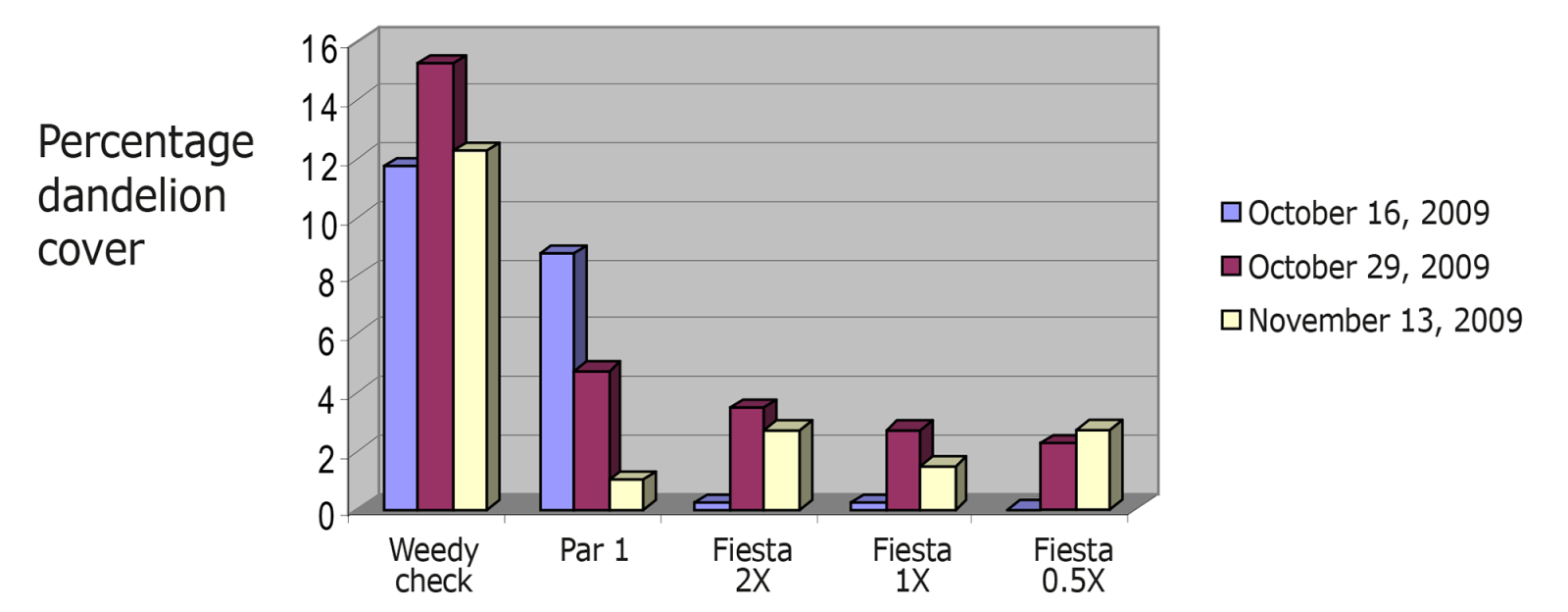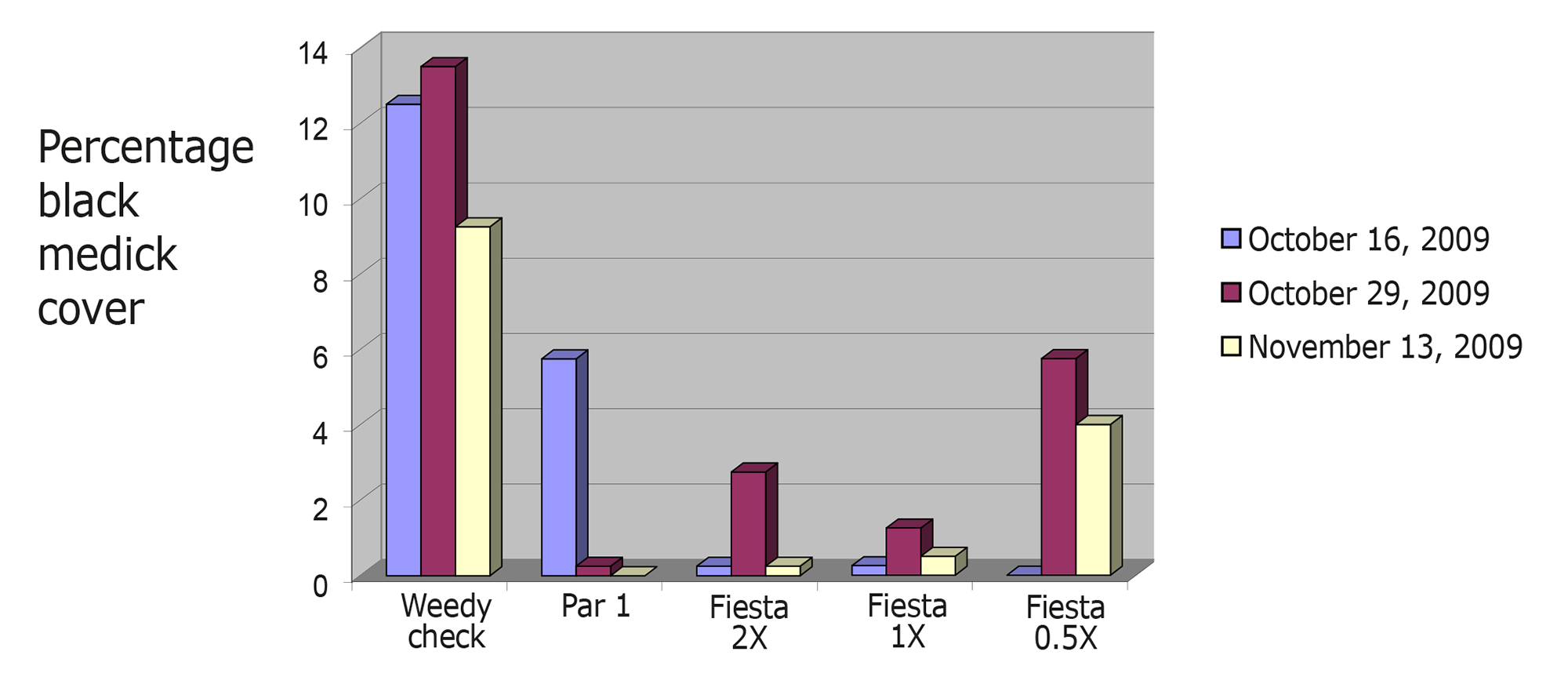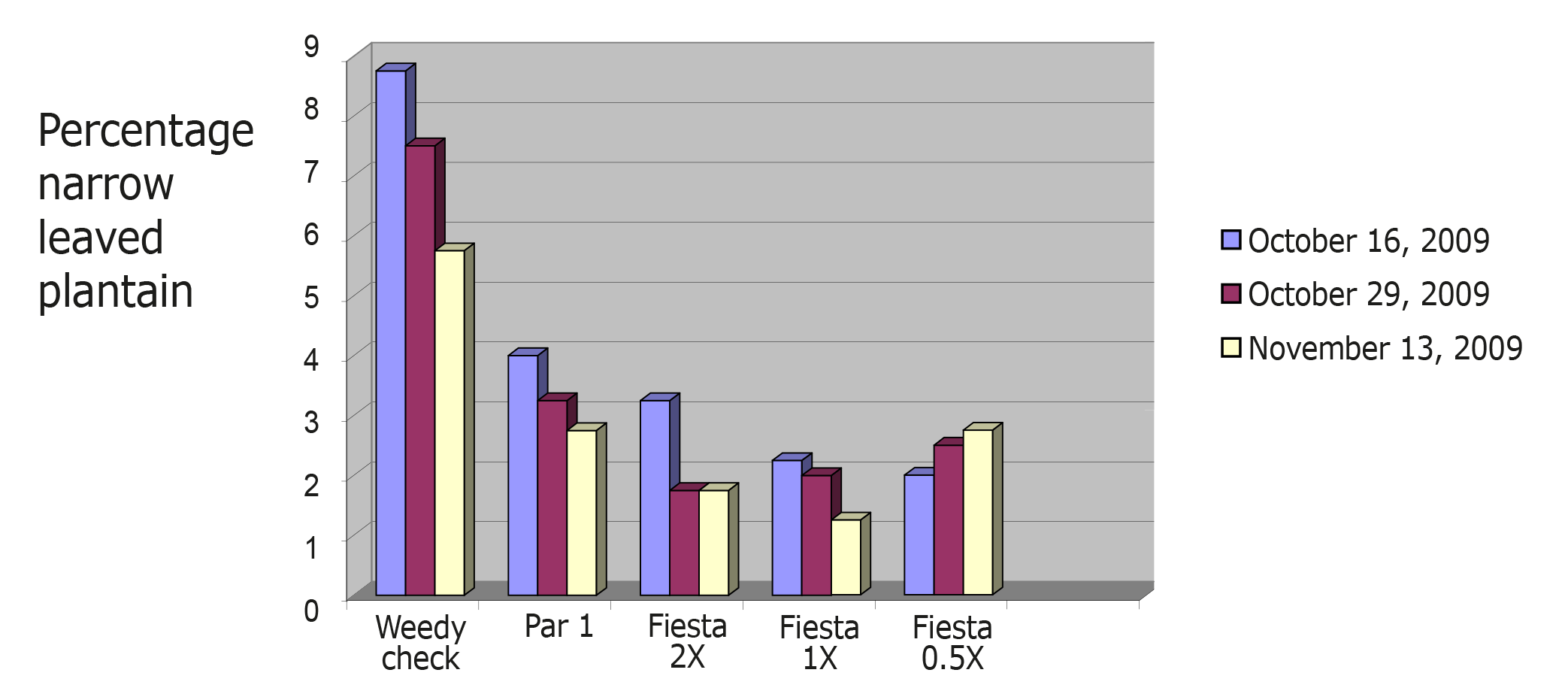May 15, 2010

Figure 1. Fiesta efficacy on dandelions.
Tests on effectiveness of Fiesta’s weed control
By Pam Charbonneau
OMAFRA Turf Specialist
Objective: To evaluate the efficacy of iron chelate for control of broadleaf weeds in turf.
The treatments were three different rates of Fiesta (active ingredient iron in the form of FeHEDTA, 4.43 per cent) from Neudorff Canada, Par III (a commercially available three-way broadleaf herbicide consisting of 2,4 D, mecoprop and dicamba) applied at label rate, and an untreated control for a total of five treatments. Fiesta was diluted with one rate (one part Fiesta with 24 parts of water and the diluted product was applied at three different rates). The rates of diluted product were 200mL/m2, 400mL/m2 and 800mL/m2. Each treatment was replicated four times in 2 x 2 m plots in a randomized complete block design. The percent of coverage of each weed species (dandelion, black medick, narrow-leaved plantain, clover and mouse-eared chickweed) was recorded in each plot at 7, 20 and 34 days after treatment (DAT). All measurements were analysed by the appropriate statistical analyses.

The same increase in percentage cover occurs with the black medick at 20 and 34 DAT, and it is higher for the 0.5X rate of Fiesta.The results for the narrow-leaved plantain show a definite rate response with the highest rate needed (2X) to control this weed species through to 34 DAT.
The per cent of black medick cover was also less than one per cent for all of the rates of Fiesta by 7 DAT (Figure 2). The per cent black medick cover increased at 20 DAT to 5.75, 1.25 and 2.75 for the 0.5X, X and 2X respectively. There was an increase in per cent of black medick at 20 DAT for the 2X rate of Fiesta and it isn’t clear what that increase can be attributed to. As would be expected, the increase in per cent cover of the black medic was highest with the lowest rate of Fiesta. As with the dandelions, the increase of black medick at the 2X rate of the Fiesta may be explained by the difference in application method, with the better coverage and the better results with the 1X rate applied with a pressurized sprayer. There was more re-growth with black medick than with the dandelion after 20 DAT. That may be related to the morphology of the weeds and the stages of growth at the time of application.
The per cent of narrow-leaved plantain cover was reduced to between 2 and 3.25 weed cover by all rates of Fiesta by 7 DAT (Figure 3). The per cent of narrow-leaved plantain was not reduced much more at the 20 DAT or 34 DAT for the 0.5X and the X, but by the 34 DAT the per cent of narrow-leaved plantain had decreased for the 2X rate of Fiesta.

The same increase in percentage cover occurs with the black medick at 20 and 34 DAT, and it is higher for the 0.5X rate of Fiesta.The results for the narrow-leaved plantain show a definite rate response with the highest rate needed (2X) to control this weed species through to 34 DAT.
With dandelions, there was an increase in per cent of dandelion cover at 20 and 34 DAT with all of the Fiesta rates. It isn’t clear from this experiment if this is dandelions that had the leaves burned off and have re-grown, or if this is because they were small dandelions that did not have contact with the Fiesta because they may have been small and below the grass canopy at the time of application. This trend is similar for black medick. Regardless of the mechanism of the return of dandelions and black medick, there may be a need for a second application to either control re-growth, or to control the smaller dandelions and black medick in the turf canopy that escaped the first treatment.
Spring efficacy research in Ontario is needed to determine if the results are similar at that time of year.
Acknowledgements: Cameron Wilson, Neudorff Canada for supplying the Fiesta.
*Rate of 1 part Fiesta/24 parts water mixture/m2
Pam Charbonneau may be contacted at 519-824-4120, ext. 52597, or by e-mail at pamela.charbonneau@ontario.ca.
Captions:
Figure 1. Fiesta efficacy on dandelions.
Figure 2. Fiesta efficacy on black medick.
Figure 3. Fiesta efficacy on narrow-leaved plantain.
OMAFRA Turf Specialist
Objective: To evaluate the efficacy of iron chelate for control of broadleaf weeds in turf.
Experimental design/methods
Plots were located in a turf research area at the Guelph Turfgrass Institute. The site is an area of established turf (a mixture of Kentucky bluegrass and turf-type perennial ryegrass infested with dandelions, black medick, narrow-leaved plantain and other lawn weeds).Turf was maintained at a low maintenance level with weekly mowing at 6 cm, no supplemental irrigation and fertilized once a year.The treatments were three different rates of Fiesta (active ingredient iron in the form of FeHEDTA, 4.43 per cent) from Neudorff Canada, Par III (a commercially available three-way broadleaf herbicide consisting of 2,4 D, mecoprop and dicamba) applied at label rate, and an untreated control for a total of five treatments. Fiesta was diluted with one rate (one part Fiesta with 24 parts of water and the diluted product was applied at three different rates). The rates of diluted product were 200mL/m2, 400mL/m2 and 800mL/m2. Each treatment was replicated four times in 2 x 2 m plots in a randomized complete block design. The percent of coverage of each weed species (dandelion, black medick, narrow-leaved plantain, clover and mouse-eared chickweed) was recorded in each plot at 7, 20 and 34 days after treatment (DAT). All measurements were analysed by the appropriate statistical analyses.
Application of treatments
The 8.6 mL/m2, 17.2 mL/m2 rates of Fiesta and Par III were applied using a CO2-powered bicycle sprayer at 20 psi at 200 and 400 of the 1 part Fiesta/24 parts water mixture, respectively.The 34.4 mL/m2 rate (800 mL/m2 of 1 part Fiesta/24 parts water) was applied using a standard 4L watering can. All treatments were applied on Oct. 9, 2009.Efficacy assessments
Efficacy assessments were made at 7, 20 and 34 DAT. Four randomized point quadrats, measuring 60 cm x 60 cm, with 25 points in each quadrat (points 10 cm apart), totalling 100 points in each plot, were used to record estimated percentage of broadleaf weed cover of dandelion, black medick, narrow-leaved plantain, broad-leaved plantain, clover and chickweed per plot at each assessment date. Weed cover of each of the species previously mentioned was also measured prior to the start of the experiment on Oct. 5, 2009. Efficacy assessment dates were Oct. 16, 2009, Oct. 29, 2009 and Nov. 13, 2009. Only data on percentage of dandelion, narrow-leaved plantain and black medick will be presented below. The percentages of broad-leaved plantain, clover and chickweed were too low to give significant differences and will not be presented in this report.Figure 2. Fiesta efficacy on black medick

The same increase in percentage cover occurs with the black medick at 20 and 34 DAT, and it is higher for the 0.5X rate of Fiesta.The results for the narrow-leaved plantain show a definite rate response with the highest rate needed (2X) to control this weed species through to 34 DAT.
Results and discussion
Visual observations made within 24 hours of applying Fiesta showed that the turf responded to the iron by greening up. This green-up lasted the entire duration of the experiment. Within 24 hours of applying Fiesta, the leaves of dandelions and black medick turned black, and within 48 hours the leaves appeared brown and shriveled. The lower leaves of narrow-leaved plantain turned black within 48 hours, but the smaller newer leaves at the centre of the rosette remained green and healthy. For dandelions, all rates of Fiesta reduced the percentage of dandelion cover to one per cent by 7 DAT (Figure 1). By 20 DAT the percent of dandelion cover increase to 2.25, 2.75 and 3.5 for the 0.5X, 1X and the 2X Fiesta respectively. The increase in per cent dandelion cover of the highest rate of Fiesta may be due to the different application method. The 2X treatment was applied by a watering can, which gave poorer coverage of the turf and weeds even though the rate was higher. The 0.5 and the 1X were applied with the pressurized sprayer which resulted in a finer spray and better coverage.The per cent of black medick cover was also less than one per cent for all of the rates of Fiesta by 7 DAT (Figure 2). The per cent black medick cover increased at 20 DAT to 5.75, 1.25 and 2.75 for the 0.5X, X and 2X respectively. There was an increase in per cent of black medick at 20 DAT for the 2X rate of Fiesta and it isn’t clear what that increase can be attributed to. As would be expected, the increase in per cent cover of the black medic was highest with the lowest rate of Fiesta. As with the dandelions, the increase of black medick at the 2X rate of the Fiesta may be explained by the difference in application method, with the better coverage and the better results with the 1X rate applied with a pressurized sprayer. There was more re-growth with black medick than with the dandelion after 20 DAT. That may be related to the morphology of the weeds and the stages of growth at the time of application.
The per cent of narrow-leaved plantain cover was reduced to between 2 and 3.25 weed cover by all rates of Fiesta by 7 DAT (Figure 3). The per cent of narrow-leaved plantain was not reduced much more at the 20 DAT or 34 DAT for the 0.5X and the X, but by the 34 DAT the per cent of narrow-leaved plantain had decreased for the 2X rate of Fiesta.
Figure 3. Fiesta efficacy on narrow-leaved plantain

The same increase in percentage cover occurs with the black medick at 20 and 34 DAT, and it is higher for the 0.5X rate of Fiesta.The results for the narrow-leaved plantain show a definite rate response with the highest rate needed (2X) to control this weed species through to 34 DAT.
With dandelions, there was an increase in per cent of dandelion cover at 20 and 34 DAT with all of the Fiesta rates. It isn’t clear from this experiment if this is dandelions that had the leaves burned off and have re-grown, or if this is because they were small dandelions that did not have contact with the Fiesta because they may have been small and below the grass canopy at the time of application. This trend is similar for black medick. Regardless of the mechanism of the return of dandelions and black medick, there may be a need for a second application to either control re-growth, or to control the smaller dandelions and black medick in the turf canopy that escaped the first treatment.
Conclusions
The new broadleaf herbicide Fiesta (active ingredient iron in the form of FeHEDTA, 4.43 per cent) has been shown to be efficacious in the control of dandelions, black medick and to a lesser degree narrow-leaved plantain during the fall. It appears from this research that coverage is important and that all applications should be made with a pressurized sprayer to insure good coverage of the product on the target weeds. For the two targeted weeds in this study, dandelion and black medick, a second application roughly four weeks after the initial application may be necessary to give season-long control of these weed species. For narrow-leaved plantain, the current label rate may not give the same per cent control as for dandelions and black medick, but the results are still very promising considering there are very few alternatives that provide this level of weed control.Spring efficacy research in Ontario is needed to determine if the results are similar at that time of year.
Acknowledgements: Cameron Wilson, Neudorff Canada for supplying the Fiesta.
Treatments
| Treatment | Active Ingredient Rate (mL/m2) | Product Rate (mL/m2) |
| 1. Untreated control | ||
| 2. Par III (2,4 D, mecoprop and dicamba) | 0.55 mL | 0.55mL/30mL water |
| 3. Fiesta 5X (lowest label rate) | 8.6 mL | 200 mL* |
| 4. Fiesta X (highest label rate) | 17.2 mL | 400 mL* |
| 5. Fiesta 2X (2 times the highest label rate) | 34.4 mL | 800 mL* |
Pam Charbonneau may be contacted at 519-824-4120, ext. 52597, or by e-mail at pamela.charbonneau@ontario.ca.
Captions:
Figure 1. Fiesta efficacy on dandelions.
Figure 2. Fiesta efficacy on black medick.
Figure 3. Fiesta efficacy on narrow-leaved plantain.